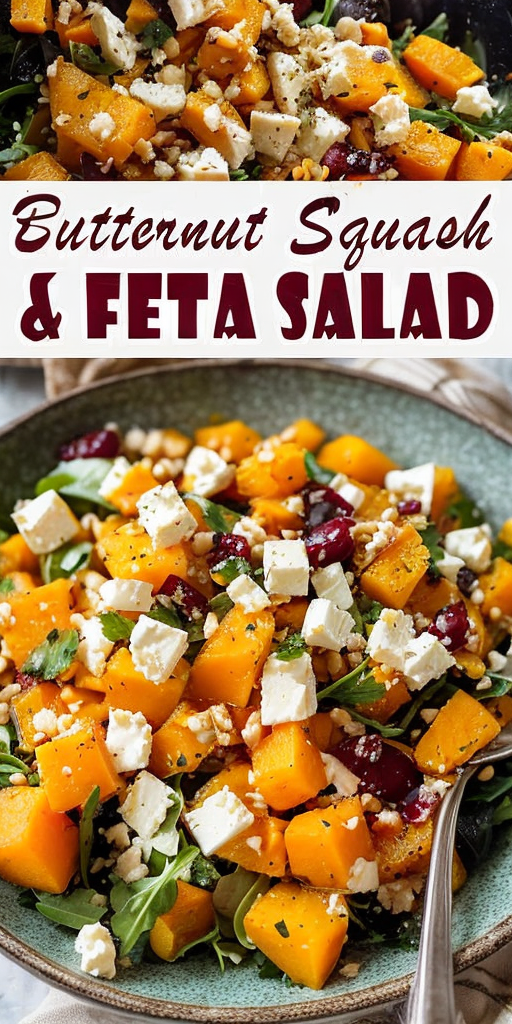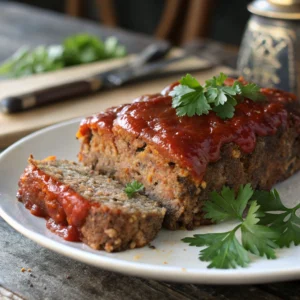Ultimate Butternut Squash and Feta Salad: A Flavorful 30-Minute Delight
Indulge in the vibrant flavors of our ultimate butternut squash and feta salad, a dish that stands out for its delightful balance of sweet and savory notes. Within just 30 minutes, you can have a beautiful, nutrient-packed salad on your table that showcases the earthy sweetness of roasted butternut squash, paired perfectly with the tangy creaminess of feta cheese. This recipe does not only satisfy your taste buds but also captivates the eyes with its colorful presentation.
Perfect for a quick lunch or a side dish to complement your dinner, this butternut squash and feta salad is a testament to how simplicity and elegance can merge in culinary creations. The roasted squash brings out a caramelized depth of flavor, while the crumbled feta introduces a salty contrast that enhances each bite. Add in the slight crunch of mixed greens and the occasional nuttiness from the pumpkin seeds, and you have a sensational dish that is both wholesome and delicious.
This salad’s aroma will fill your kitchen with a warm, inviting scent that is undeniably comforting. The fragrances of roasted squash and fresh herbs blend together, creating an aromatic profile that is both earthy and refreshing. Visually, this dish is a feast for the eyes, with its vivid orange squash, crisp green leaves, and stark white feta, making it not only tasty but also stunning to behold.
Quick Recipe Highlights
- Flavor Profile: A harmonious mix of earthy, sweet squash balanced by tangy feta and a hint of freshness from herbs and greens.
- Texture: Perfect balance of tender roasted squash, creamy cheese, with bursts of crunchiness from seeds.
- Aroma: Warm, roasted vegetable notes mingling with the fragrance of fresh herbs.
- Visual Appeal: A vibrant medley of orange, green, and white, offering a pleasing contrast and an inviting presentation.
- Skill Level Needed: Easy enough for beginners, requiring basic roasting techniques and salad assembly skills.
- Special Equipment: Baking sheet and mixing bowls.
Recipe Overview
- Difficulty Level: Considered easy, this recipe is ideal for those who are new to cooking or in search of a quick, flavorful meal without complex steps.
- Category: Best suited as a side dish or a light main meal that satisfies both in flavor and nutrition.
- Cuisine: While it leans towards Mediterranean influences due to the feta and olive oil, this dish is versatile enough to fit various meal traditions.
- Cost: Relatively affordable, with the most significant cost being the butternut squash and feta cheese.
- Season: Best enjoyed in fall and winter when squash is in season, though it remains a pleasant dish year-round.
- Occasion: Suitable for casual family meals, holiday gatherings, or as a vibrant offering at a potluck.
Why You’ll Love This Recipe
The contrast of flavors and textures in this ultimate butternut squash and feta salad is truly a delight. The sweetness of roasted squash pairs beautifully with the tanginess of feta, creating a palate-pleasing dish that satisfies cravings for both sweet and savory. The crunchy seeds add another dimension, making every bite an exploration of taste and texture.
Convenience is another reason you’ll adore this dish. It requires minimal prep time, and the cooking process is straightforward, using common kitchen equipment. This ease of preparation allows you to enjoy a gourmet-quality meal without spending hours in the kitchen.
Nutritionally, this salad packs a punch by incorporating nutrient-rich ingredients like butternut squash, known for its vitamins and fiber, and greens, which add a variety of essential nutrients. Together, they create a dish that is not only flavorful but also beneficial for your health.
Socially, this recipe shines as a crowd-pleaser. It’s the perfect choice for gatherings, offering a visually appealing and festive dish that invites compliments. Its unique flavor profile makes it a standout option at any potluck or dinner party, ensuring that it will be a talking point among your guests.
Finally, the cost-effectiveness of this salad makes it a go-to for those eating on a budget. With simple ingredients that are easy to source, you can enjoy a gourmet meal without breaking the bank. This accessibility ensures that everyone can savor its wonderful flavors.
Historical Background and Cultural Significance
The origin of this particular combination of butternut squash and feta is rooted in the Mediterranean’s rich culinary traditions, where the love for fresh, flavorful, and wholesome ingredients is prominent. Traditional Mediterranean dishes emphasize the importance of simplicity and quality, which can be seen in the use of high-quality olive oil and fresh herbs.
Culturally, the incorporation of butternut squash—a native ingredient to the Americas—adds a layer of fusion and innovation. While squash itself was traditionally used by Native Americans, it has been widely embraced globally, finding its way into various cuisines as a versatile ingredient.
Over time, the recipe has evolved to incorporate contemporary trends such as adding nuts and seeds for both texture and nutritional value. This evolution reflects a broader trend toward healthy, balanced meals that nutritional science supports.
Regional variations of this dish can be found, with some recipes enhancing the mix by including ingredients like pomegranate seeds or different types of cheese. These adaptations highlight the diversity and adaptability of this delightful salad, allowing it to fit into various cultural contexts and personal preferences.
Ingredient Deep Dive
Butternut squash, the star of this salad, has been cherished for centuries, first cultivated by indigenous peoples in North America. Its natural sweetness and versatility make it a beloved ingredient across many cultures. Nutritionally, butternut squash is a powerhouse, rich in vitamins A and C, and fiber, supporting healthy vision and digestion. When selecting squash, look for one that feels heavy for its size, with a hard, defect-free skin, and store it in a cool, dry place for extended freshness. If needed, substitute it with acorn squash or sweet potatoes.
Meanwhile, feta cheese adds a complementary tangy component that balances the sweetness of the squash. Originating from Greece, feta is traditionally made from sheep’s milk, cherished for its distinct crumbly texture and robust flavor. It’s a great source of calcium and protein, delivering essential nutrients with each bite. Store feta in brine—if possible— to maintain freshness, or its package until use. In case of unavailability, goat cheese serves as an excellent alternative for a similar tangy flavor and creamy texture.
Common Mistakes to Avoid
- Overcooking the squash can lead to a mushy texture, so monitor roasting closely.
- Not seasoning adequately might result in a bland salad; be generous with spices and herbs.
- Skipping toasting the seeds can miss the opportunity for extra crunch and flavor.
- Using low-quality olive oil might affect the overall flavor, so opt for extra-virgin when possible.
- Not allowing the squash to cool slightly before combining, which could wilt the greens.
- Overdressing can make the salad soggy and overpower other flavors; drizzle dressing gradually.
- Incorrect storage post-cooking can compromise the dish’s freshness; refrigerate promptly.
- Ignoring ingredient freshness; stale spices or wilted greens detract from the taste.
Essential Techniques
Roasting the squash perfectly is crucial for this recipe’s success. This technique enhances the natural sweetness and achieves the desired caramelization. Aim for evenly sized cubes to ensure even cooking, and place them on a single layer to avoid steaming. Watch for caramelized edges as a visual cue for doneness.
Mastering dressing the salad is another key component. Start by mixing the dressing ingredients in a separate bowl, which allows for easier adjustment of flavors. Gradually drizzle the dressing over the salad, tossing gently to ensure even distribution without oversaturating the greens.
Pro Tips for Perfect Ultimate Butternut Squash and Feta Salad
Choosing a ripe butternut squash with vibrant color and firmness will ensure the sweetest flavor. Consider adding a splash of honey or maple syrup to the roasting squash for a deeper caramelization. Enhance the flavor by including a squeeze of lemon juice in the dressing, which adds brightness and acidity. Toast the seeds beforehand for increased crunchiness and aroma. Use fresh herbs liberally for that vivid, aromatic touch. Try integrating different textures by including crunchy vegetables like cucumbers or jicama for added bite.
Variations and Adaptations
For those who appreciate regional cuisine twists, integrating pomegranate seeds can give this dish a Middle Eastern flair with their tartness. Seasonal adaptations are effortless; in summer, swap squash for grilled zucchini or eggplant to keep things fresh. Dietary modifications like making it vegan are straightforward by using vegan feta alternatives. For flavor variations, add a dash of smoked paprika or cumin for a smoky depth.
In terms of texture, incorporating grated raw beets or carrots can add a crisp crunch, while avocado slices provide a smooth, creamy contrast. If you’re looking to elevate presentation, lay the ingredients in a deconstructed manner on a platter to impress guests with a modern salad bar-like appeal.
Serving and Presentation Guide
For an inviting presentation, spread the roasted squash in a centered layer, artfully arranged with greens cascading around it. Sprinkle feta and seeds over for a spot of color and texture. Use broad plates to provide room for the vibrant palette to shine. For traditional accompaniments, serve with warm pita or crusty bread. Modern serving suggests a chilled plate to keep greens crisp. For portion control, serve as an appetizer or starter in smaller bowls. Consider the temperature; ideally, serve when squash is slightly warm, allowing flavors to blend beautifully.
Wine and Beverage Pairing
This salad pairs beautifully with a crisp, chilled white wine like Sauvignon Blanc, which complements the tangy feta and sweet squash. Alternatively, opt for a light, floral rosé for a hint of elegance. For non-alcoholic choices, a homemade herbal iced tea with subtle hints of mint and lemon can elevate the meal. If coffee or tea complements are desired, consider a gentle rooibos tea served lukewarm, which pairs well with the dish’s balanced flavors.
Storage and Shelf Life
Store any leftovers in an airtight container in the refrigerator where they will stay fresh for up to two days. Always separate the dressing to prevent the salad from becoming soggy. For optimal freshness, pack the squash separately from greens to avoid wilting. Reheat the squash lightly in the oven rather than microwave to preserve its texture when consuming as leftovers. Freezing is not recommended due to the greens and feta, which alter texture upon thawing.
Make Ahead Strategies
To expedite meal prep, roast the butternut squash in advance and store it in the fridge until needed. Prepare the dressing separately and store it in a sealed jar for up to a week. When ready to assemble, simply toss all elements together, ensuring the squash is at room temperature for the best flavor experience. Adding herbs and seeds last ensures they remain fresh and crisp upon serving.
Scaling Instructions
Easily scale the recipe to suit larger gatherings by doubling or tripling the ingredients. Utilize sheet pans for roasting more squash simultaneously, ensuring even roasting. Keep in mind that the cooking time might extend slightly, so monitor closely to prevent over-browning. When halving, the recipe remains consistent in steps and timing, with the only change being ingredient reduction. Adjust storage by using appropriate-sized storage containers to maximize freshness for larger quantities.
Nutritional Deep Dive
This salad is a nutritional powerhouse, offering a balanced macro makeup of carbohydrates from squash, healthy fats from the olive oil and feta, and protein from the cheese. With ample fiber and vitamins like A and C from the vegetables, it supports overall wellness and immune function. Suitable for most diets, its nutrient-rich profile promotes satiety without excess calories. For those mindful of sodium, reducing feta or opting for a lower-sodium alternative can provide a lighter option.
Dietary Adaptations
To make this salad gluten-free, ensure any bread accompaniments are gluten-free. For a dairy-free adaptation, replace feta with dairy-free cheese alternatives or sprinkle nutritional yeast for a cheesy flavor. Adapting to a vegan diet involves using plant-based cheese and checking that all ingredients, especially olive oil, are vegan-certified. Those following a low-carb or keto lifestyle can reduce or omit the squash and incorporate more leafy greens or avocado to maintain texture and flavor.
The Recipe
Ultimate Butternut Squash and Feta Salad
Serves: 4
Prep Time: 10 mins
Cook Time: 20 mins
Total Time: 30 mins
Kitchen Equipment Needed
- Baking sheet
- Mixing bowls
- Knife
- Cutting board
Ingredients
- 1 butternut squash, peeled and cubed
- 2 tablespoons olive oil
- Salt and pepper to taste
- 4 cups mixed salad greens
- 1/2 cup feta cheese, crumbled
- 1/4 cup pumpkin seeds, toasted
- 1 tablespoon fresh lemon juice
- 1 tablespoon balsamic vinegar
- 1 teaspoon honey or maple syrup (optional)
Directions
- Preheat your oven to 400°F (200°C). Spread the cubed butternut squash evenly on a baking sheet.
- Drizzle with olive oil, salt, and pepper. Roast for about 20 minutes, or until tender and caramelized.
- In a small bowl, whisk together lemon juice, balsamic vinegar, and honey (if using) to create the dressing.
- In a large mixing bowl, combine mixed greens, roasted squash, and pumpkin seeds.
- Drizzle the dressing over the salad and toss gently to combine.
- Top with crumbled feta cheese just before serving. Enjoy immediately!
Recipe Notes
- Feel free to substitute butternut squash with sweet potatoes for a similar flavor.
- Adjust the seed choice based on personal preference, such as using sunflower seeds.
- For added protein, incorporate cooked quinoa into the salad mix.
Troubleshooting Guide
If you encounter texture issues where squash is too soft, consider roasting in single layers on a higher rack. Balance flavors by adjusting the salt and acid levels if found too bland or too tangy. For temperature concerns, ensure the salad is at room temperature before serving, as a chilled squash can mute flavors. Equipment challenges like unequal baking can be solved by rotating baking sheets halfway. Experiment with ingredient substitutions like varying cheeses or nuts to suit your taste.
Recipe Success Stories
Our community members rave about incorporating seasonal variations, with many loving the addition of vibrant pomegranate pearls in winter. Reader suggestions have brought forth exciting adaptations, such as integrating grilled halloumi instead of feta. One user transformed the salad into a full meal by adding grilled chicken, winning acclaim for its simplicity and deliciousness. Photography tips recommend angled shots that showcase every layer coined by readers for that professional flair.
Frequently Asked Questions
What can I use instead of feta cheese if I’m lactose intolerant?
Trying a lactose-free cheese or vegan cheese offers a similar creamy texture while maintaining the salad’s integrity.
How can I make this salad spicy?
For a kick, add a sprinkle of red pepper flakes or a dash of hot sauce to the dressing.
Can I use pre-cut squash?
Pre-cut butternut squash can be a time-saving alternative, just ensure it is fresh for optimal flavor.
What is the best way to roast seeds?
Simply spread them on a baking sheet and toast in the oven for 5-7 minutes at 350°F (175°C) until golden.
Is it possible to make this salad nut-free?
Certainly, omit seeds or replace with dried fruits for sweetness without nuts.
How long ahead can I prep this salad?
Components can be prepped and stored separately up to 2 days in advance, assembling just before serving.
What’s the best substitute for honey in the dressing?
Maple syrup or agave serve as effective substitutes for a similar sweetness in vegan options.
Can I use frozen squash for this salad?
Fresh is preferable, but thawed and drained frozen squash can be used with slight texture differences.
Does this salad taste good cold?
While best slightly warm, it can be enjoyed cold; consider extra dressing to maintain flavor balance.
How to store leftovers for best reheating?
Store components separately in airtight containers, keeping the dressing aside to avoid wilting.
Additional Resources
For those interested in expanding their culinary skills, explore guides on perfect roasting techniques or delve into the rich history of Mediterranean cuisine. Discover complementary recipes like roasted vegetable medleys or refreshing citrus salads that pair beautifully with this dish. Consider equipment recommendations, including superior quality knives to aid in precise and efficient cutting. Seasonal variations extend this recipe’s versatility, inviting endless exploration in culinary creativity.
Join the Conversation
Share your culinary masterpieces on social media and inspire others with creative takes on the ultimate butternut squash and feta salad. Exchange tips on photography and food styling to capture the dish’s vibrant essence. Engage with the community, offering reviews or feedback that supports recipe refinement. Explore and share variations that highlight unique regional ingredients and personal touches, inspiring others to partake in the joyous art of cooking and sharing wholesome food.



